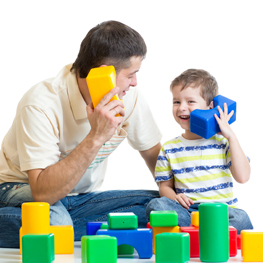
Do you want to have interesting conversations and communicate openly with your teenager? Here’s a secret: Developing a strong communication connection with your child begins by learning the best ways to communicate with your preschool-age child.
Why communication interactions with kids are so important, even for their brain development
Apple Magazine and the Alberta Family Wellness Initiative website feature cutting edge brain research, which validates that back-and-forth, continuous communication interactions or turns are beneficial for children. If you want kids to progress faster with their speech, language and communication skills, give them lots of opportunities to take uninterrupted, back-and-forth communication turns with you.
How to first engage with your child so they will have fun joining in for continuous communication turns
Something that speech-language pathologists do before every session and activity is to get engaged with your child. Engagement is when you are tuned into your child so well they are connected with you and the best part is, your child will then want to interact, play and talk with you. Now you are ready to begin continuous communication turns.
For engagement to work for your child, keep these two tips in mind:
You need to have confidence in your belief your child will want to join in communication turns with you (you can become ‘super fun practice cheerleader’ or ‘cool practice coach’).
Your feeling that you want to have fun and practice with your child must be genuine. Kids pick up on our feelings.
Because kids have different personalities and communication preferences, it’s helpful to know a variety of ways to have fun while engaging with your child. Here are three play-based approaches to choose from to entice your child to engage with you:
Bring out an adorable puppet or stuffed animal and playfully persist to encourage your child’s participation. An example of what you could say is: “I’m so sad. I can’t say any of these /s/ sound words. I have an idea. You know these /s/ words! Here, tell me this one! You know this one too!”
Invite your child to have crazy active fun with you. Look around a room, pretending to search like a detective. Then, you could say, “[Michael], you need to see this!” (Look around again.) “All the ‘snake’ sound cards are missing. We can find them!”
Join in and play with your child and add in a surprise twist. Drop a block before you say something like, “Did you hear that?! There’s a ‘snake’ sound in the word ‘same.’”
Tips and activities that add fun and ease to communication turns
Entice your child to take their communication turns. How? Light up with your eyes and face after your turns and lean forward as you wait with eager anticipation for your child to take their turns. Your child may need for you to wait 10 to 15 seconds.
Fun activity - Take turns naming toys or objects that you pull out of a ‘mystery’ bag or take turns finding and naming hidden picture cards.
Listen to each other. How? One person talks while the other person stops moving, listens and watches. Have your child squeeze their hands together while listening. Make your turns quick.
Stop-listen-watch.
Fun activity - Before you give your child a direction for something they would like to do, stop what they are doing, wait for them to listen to you and encourage them to watch you.
Praise your child after they take their communication turn. How? Give positive and genuine praise.
Fun activity - While you each do artwork with art materials your child loves using, give your child praise after they say something about their picture. For example, “Good one!”; “I understood you!”; “That sounded clear!”; “You’re trying hard!”; “I like how you said that”; “You’re getting better!”; “I heard you!”; “Wow, look at you improving!”; “Nice job!”; “That was clear!”
When you love joining in and engaging in communication with your child so much, the experience shall become a communication party!
How will you join in and start a communication party with your child?
Keri Vandongen is a local speech-language pathologist (SLP) who loves having fun with young kids and connecting with their families. She created Speech Party as an online place to educate, collaborate with and support parents who want to learn the best ways to help or practice speech with their kids. For more information about Speech Party, visit myspeechparty.com.
Calgary’s Child Magazine © 2024 Calgary’s Child